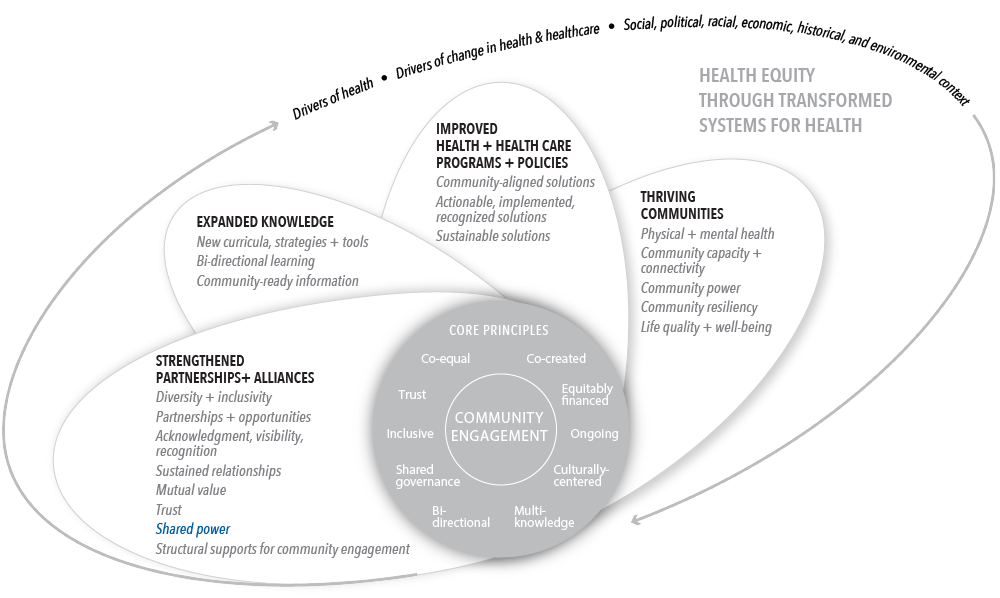Assessing Meaningful Community Engagement
Three-Model Approach
KEY FEATURES
COMMUNITY/ GEOGRAPHY
Academic partners
Community partners
Mental health
Substance abuse
Behavioral health
United States
COMMUNITY ENGAGEMENT OUTCOMES
Strengthened partnerships + alliances
Shared power
PLACE(S) OF INSTRUMENT USE
Community/community-based organization
Academic/research institution/university
LANGUAGE TRANSLATIONS
Not specified
PSYCHOMETRIC PROPERTIES
Content validity
Face validity
YEAR OF USE
2010
Assessment Instrument Overview
The Three-Model Approach has three questions and is used in community partnered research. It presents three different models of partnership for use by community partners to describe their participation in the research process. The Three-Model Approach is part of a set of two instruments that also includes the Community Engagement in Research Index (CERI).
Alignment with Assessing Meaningful Community Engagement Conceptual Model
The questions in Three-Model Approach were aligned to the Assessing Community Engagement Conceptual Model. Figure 1 displays the alignment of the Three-Model Approach with the Conceptual Model domain(s) and indicator(s). Where an instrument is mapped broadly with a domain or with a specific indicator, the figure shows the alignment in blue font.
Table 1 displays the alignment of the Three-Model Approach with the Conceptual Model domain(s) and indicator(s). The table shows, from left to right, the aligned Conceptual Model domain(s) and indicator(s) and the individual questions from the Three-Model Approach transcribed as they appear in the instrument (with minor formatting changes for clarity).
| CONCEPTUAL MODEL DOMAIN(S) AND INDICATOR(S) | ASSESSMENT INSTRUMENT QUESTIONS |
| STRENGTHENED PARTNERSHIPS + ALLIANCES; Shared power | As you may know, there are different models of conducting partnered research projects. for example: in model A, community partners only provide access to study subjects and are not engaged in the research aspects of the project. In model B, community partners are consulted and act as advisors, but do not make any research-related decisions. In model C, community partners engage in the research activities, i.e., study design, data collection, and/or data analysis. Which of the three models best describes this partnership? Could you please describe what your community partners did and what role they played on this project? |
Table 1 | Three-Model Approach questions and alignment with the domain(s) and indicator(s) of the Assessing Community Engagement Conceptual Model
ASSESSMENT INSTRUMENT BACKGROUND
Context of instrument development/use
The article discusses the Partnership Evaluation Study (PES), which used a mixed-methods approach to evaluate partnered research projects. Two assessment instruments were developed for the study: the Three-Model Approach to look at “levels of community participation” (discussed here) and the CERI (discussed in another assessment instrument summary) to assess the “multidimensional view of community participation in the research process.” The Three-Model Approach allowed those participating in PES to differentiate between levels of participation among community partners in research projects using closed-ended questions. The development of the Three-Model Approach was a precursor to the development of CERI.
Instrument description/purpose
The Three-Model Approach identifies three different partnership models and distinguishes between “academic-led projects with community partners assisting in defining the research question and truly partnered projects with academics and community members jointly working on all research-related tasks.” It reflects a straightforward way for community partners to describe their participation in the research process. The three different partnership models include:
- “Model A = community partners only provide access to study subjects and are not engaged in the research aspects of the project.
- Model B = community partners are consulted and act as advisors, but do not make any research related decisions.
- Model C = community partners engage in the research activities, that is, study design, data collection and/or data analysis.”
The Three-Model Approach can be accessed here: https://doi.org/10.1177/1090198112459050. The last question of the instrument on the role of community partners in the project, noted in Table 1, was identified through personal communication with the article’s first author.
Engagement involved in developing, implementing, or evaluating the assessment instrument
PES “was co-developed and co-led by an academic investigator and a community partner and included both academic and community personnel as staff.” The projects evaluated in PES “focused on pressing mental health and substance abuse issues, and partner organizations included research and educational institutions, faith-based and community-based organizations, homelessness agencies, health insurance companies, and various state agencies.” Principal investigators were interviewed using a semi-structured guide. Online surveys were conducted with academic and community partners that were working on the projects. This helped to gain a better understanding of the aspects in which communities partners participate, as well as to assess the perceived influence that community participation had on the project and on outcomes.
Additional information on populations engaged in instrument use
Not specified.
Notes
- Potential limitations: The findings “are based on a limited sample of projects, all of which dealt with a behavioral health issue and were affiliated with an [National Institute of Mental Health]-funded center.” Additionally, terms such as “consulted on” and “were actively engaged in,” used in the evaluation, may have been defined and interpreted differently by participants. Further, not all participants who were invited to join the study participated.
- Important findings: The results from the interviews “suggested that a multidimensional approach to measuring community participation in research was necessary to address the challenges associated with the evolution of partnerships and to capture the wide variation in community participation in research activities.” Additionally, the Three-Model Approach, which has high face validity, provides a simple framework that supports follow-up with open-ended questions about the engagement of community partners in research. Of note, the findings from the study indicate differences in responses between academic and community partners within the same project and that consensus typically took place when projects were classified as either Model A or Model C. “Although useful for uncovering complexity of community participation in research, such as identifying the difference in community and academic perspectives and illustrating how community partners’ roles change as the project evolves, the [Three-Model Approach] may not be the best choice for capturing, and assigning numeric values to, multiple dimensions of community engagement, which suggests that it may suffer from low level of content validity. …While additional research is needed to validate these measures, [the] study makes a significant contribution by illustrating the complexity of measuring community participation in research and the lack of reliability in simple scores offered by the Three-Model Approach. Researchers and community partners may also find [the instrument] useful for formative evaluation, tracking the extent and type of community engagement over time.”
- Future research needed:
- The authors have proposed further research on “advancing the science of measuring community engagement in research,” including:
- To what degree do these … measures operate in a theoretically expected way?
- How does perception of community participation in research vary depending on the project’s substantive focus or goals?
- Is there a consistent response bias on either the community or the academic side in responding to questions about community engagement in research?
We want to hear from you!
Assessing community engagement involves the participation of many stakeholders. Click here to share feedback on these resources, or email [email protected] and include “measure engagement” in the subject line to learn more about the NAM’s Assessing Community Engagement project.
Related Products


